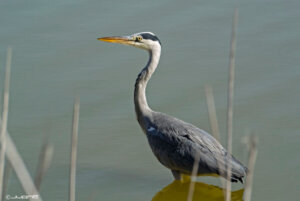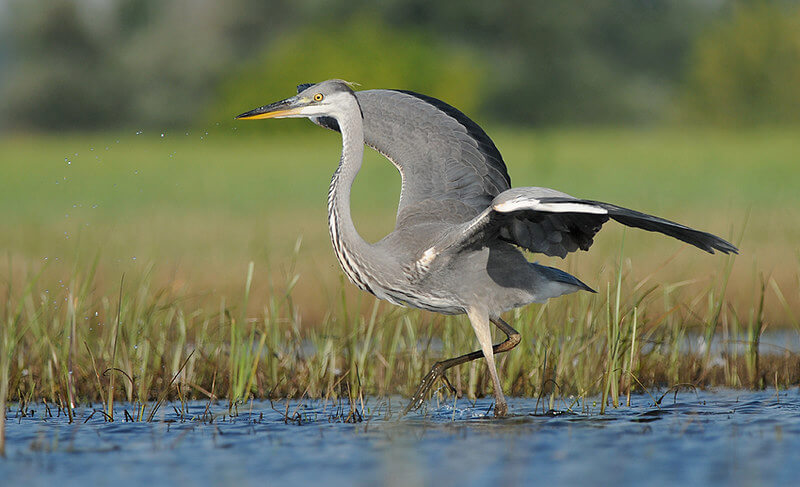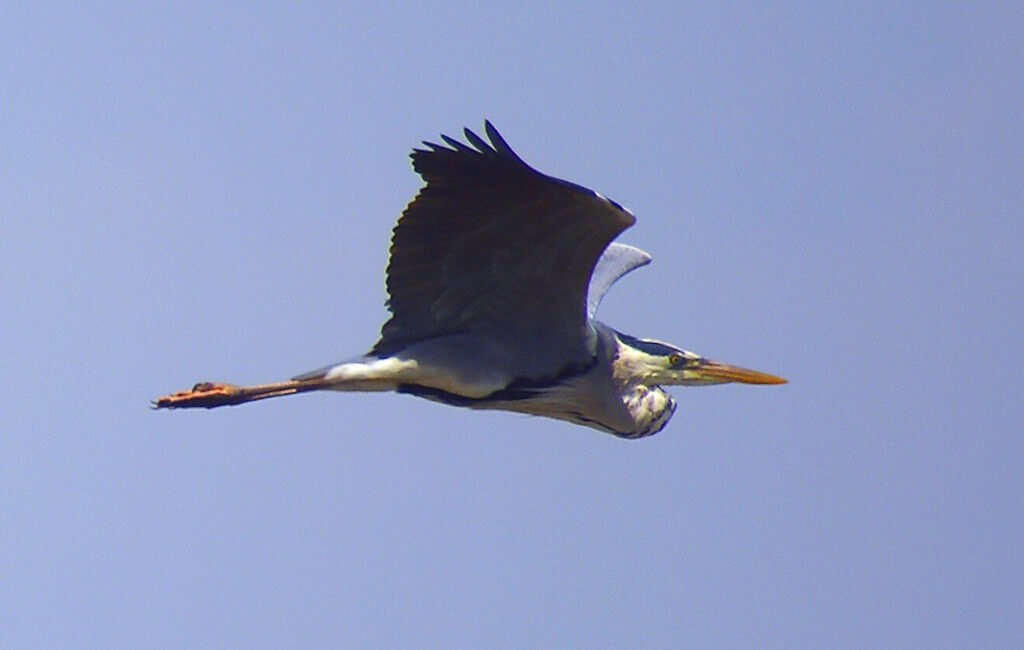The Grey Heron: Habitat, Characteristics, and Curiosities


Written and verified by the biologist Cesar Paul Gonzalez Gonzalez
The grey heron is a large long-necked bird that lives in the old world. Because it has aquatic habits, it’s common to observe it spending much of its time in the water or at the water’s edge. However, it also leaves its habitat to migrate in search of warmer climes.
The scientific name of this species is Ardea cinerea. It belongs to the family Ardeidae, which contains several types of herons, egrets, and night herons. All of them are characterized by their slender, tall bodies and a long, flexible neck that distinguishes them from other birds. Continue reading to discover more about this fascinating animal.
Habitat and distribution
The distribution of the grey heron is very extensive in the old continent, as it naturally covers a large part of Eurasia and Africa. However, some specimens have been sighted in North America, Australia, and Greenland.
As mentioned, this bird is aquatic and is highly dependent on the existence of a body of water (either fresh or salt). For this reason, it can be found in estuaries, rivers, lakes, marshes and near the sea, although it prefers shallow areas, since this makes it easier to capture its food.

Physical characteristics of the grey heron
The grey heron has an elongated body that measures between 84 and 102 centimeters (33 to 40 inches) in height, with a wingspan of between 155 and 175 centimeters (61 to 69 inches) in length. However, it has a slender build and barely exceeds one kilogram. In addition, it has a small beak, its neck is flexible, and it can elongate or contract it to amplify the magnitude of its movements.
Contrary to other aquatic birds, the grey heron doesn’t usually float or swim in the bodies of water it inhabits, but stops in shallow areas to feed. In fact, its long legs help it to support itself without getting its plumage wet.
As for its coloration, this bird has gray plumage all over its body, with some black and white spots on its head and on the outline of its limbs. Also, not all of its plumage is smooth; it has some long, fluffy feathers on its crest and neck, which makes it look like it has a tuft and beard.
Behavior
A curious aspect of the grey heron is that the availability of resources influences its behavior. When there’s enough food for everyone, they coexist peacefully with other birds. But, as soon as food becomes scarce, they become aggressive, even within the nest. This could lead to infanticide, one of the most significant causes of mortality in chicks.
Herons also have a peculiar way of showing their dissatisfaction with their conspecifics: they raise their tufts as a sign of aggressiveness and territoriality. Some even move their flexible necks to make the signal even clearer and get intruders to move away as soon as possible.
Grey heron diet
The diet of the grey heron consists of different types of fish, although it sometimes consumes other prey such as insects, crustaceans, frogs, and some small mammals. Its hunting technique is based on waiting for a fish to pass by and catching it with a quick movement. This is why it’s normal to see it standing in the middle of a body of water for long periods of time.
Reproduction
The grey heron’s breeding season begins in February and ends in June. At first, the males spread out all over the territory in search of a good nesting site in the trees. As soon as they find it, they’ll start emitting different vocalizations in order to attract potential mates.

Contrary to what happens with other birds, in this species not only do the females have the ability to choose, but the males also decide whether or not to accept their partner. If both “accept” each other, the male will begin to “dance” with his whole body to try to get the female to agree to mate.
When the pair starts to groom each other, it means that they have formalized their relationship and won’t separate unless one of them dies (monogamy). After courtship, the two begin nest building and the female will lay 3 to 5 eggs per season. The young will hatch at 26 days on average and will be cared for by their parents until they’re independent (in around 14 weeks).
As you can tell, the grey heron is a common and interesting old-world species. While it shares many physical characteristics with other herons, this one stands out for its behavior and its peculiar bulky plumage. This beautiful bird is a powerful example of how wonderful and complex nature can be.
The grey heron is a large long-necked bird that lives in the old world. Because it has aquatic habits, it’s common to observe it spending much of its time in the water or at the water’s edge. However, it also leaves its habitat to migrate in search of warmer climes.
The scientific name of this species is Ardea cinerea. It belongs to the family Ardeidae, which contains several types of herons, egrets, and night herons. All of them are characterized by their slender, tall bodies and a long, flexible neck that distinguishes them from other birds. Continue reading to discover more about this fascinating animal.
Habitat and distribution
The distribution of the grey heron is very extensive in the old continent, as it naturally covers a large part of Eurasia and Africa. However, some specimens have been sighted in North America, Australia, and Greenland.
As mentioned, this bird is aquatic and is highly dependent on the existence of a body of water (either fresh or salt). For this reason, it can be found in estuaries, rivers, lakes, marshes and near the sea, although it prefers shallow areas, since this makes it easier to capture its food.

Physical characteristics of the grey heron
The grey heron has an elongated body that measures between 84 and 102 centimeters (33 to 40 inches) in height, with a wingspan of between 155 and 175 centimeters (61 to 69 inches) in length. However, it has a slender build and barely exceeds one kilogram. In addition, it has a small beak, its neck is flexible, and it can elongate or contract it to amplify the magnitude of its movements.
Contrary to other aquatic birds, the grey heron doesn’t usually float or swim in the bodies of water it inhabits, but stops in shallow areas to feed. In fact, its long legs help it to support itself without getting its plumage wet.
As for its coloration, this bird has gray plumage all over its body, with some black and white spots on its head and on the outline of its limbs. Also, not all of its plumage is smooth; it has some long, fluffy feathers on its crest and neck, which makes it look like it has a tuft and beard.
Behavior
A curious aspect of the grey heron is that the availability of resources influences its behavior. When there’s enough food for everyone, they coexist peacefully with other birds. But, as soon as food becomes scarce, they become aggressive, even within the nest. This could lead to infanticide, one of the most significant causes of mortality in chicks.
Herons also have a peculiar way of showing their dissatisfaction with their conspecifics: they raise their tufts as a sign of aggressiveness and territoriality. Some even move their flexible necks to make the signal even clearer and get intruders to move away as soon as possible.
Grey heron diet
The diet of the grey heron consists of different types of fish, although it sometimes consumes other prey such as insects, crustaceans, frogs, and some small mammals. Its hunting technique is based on waiting for a fish to pass by and catching it with a quick movement. This is why it’s normal to see it standing in the middle of a body of water for long periods of time.
Reproduction
The grey heron’s breeding season begins in February and ends in June. At first, the males spread out all over the territory in search of a good nesting site in the trees. As soon as they find it, they’ll start emitting different vocalizations in order to attract potential mates.

Contrary to what happens with other birds, in this species not only do the females have the ability to choose, but the males also decide whether or not to accept their partner. If both “accept” each other, the male will begin to “dance” with his whole body to try to get the female to agree to mate.
When the pair starts to groom each other, it means that they have formalized their relationship and won’t separate unless one of them dies (monogamy). After courtship, the two begin nest building and the female will lay 3 to 5 eggs per season. The young will hatch at 26 days on average and will be cared for by their parents until they’re independent (in around 14 weeks).
As you can tell, the grey heron is a common and interesting old-world species. While it shares many physical characteristics with other herons, this one stands out for its behavior and its peculiar bulky plumage. This beautiful bird is a powerful example of how wonderful and complex nature can be.
All cited sources were thoroughly reviewed by our team to ensure their quality, reliability, currency, and validity. The bibliography of this article was considered reliable and of academic or scientific accuracy.
- Dimalexis, A., Pyrovetsi, M., & Sgardelis, S. (1997). Foraging ecology of the grey heron (Ardea cinerea), great egret (Ardea alba) and little egret (Egretta garzetta) in response to habitat, at 2 Greek wetlands. Colonial waterbirds, 261-272.
- Jakubas, D. (2005). Factors affecting the breeding success of the grey heron (Ardea cinerea) in northern Poland. Journal of Ornithology, 146(1), 27-33.
- Renner, M., & Linegar, P. D. (2007). The first specimen record of Gray Heron (Ardea cinerea) for North America. The Wilson Journal of Ornithology, 119(1), 134-136.
- Butler, R. W. (1991). Habitat selection and time of breeding in the great blue heron,(Ardea herodias) (Doctoral dissertation, University of British Columbia).
- Marion, L. (1989). Territorial feeding and colonial breeding are not mutually exclusive: the case of the Grey Heron (Ardea cinerea). The Journal of Animal Ecology, 693-710.
- Bower, J. and D. Rabago. (2012). “Ardea cinerea” (On-line), Animal Diversity Web. Recuperado el 19 de enero de 2023, disponible en: https://animaldiversity.org/accounts/Ardea_cinerea/
This text is provided for informational purposes only and does not replace consultation with a professional. If in doubt, consult your specialist.








